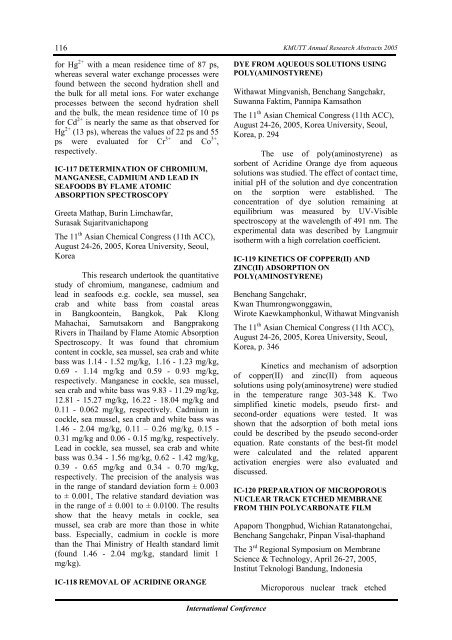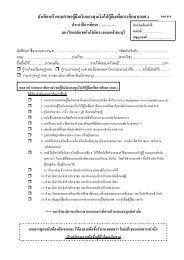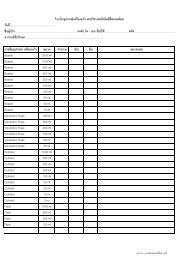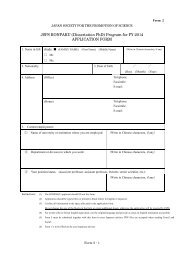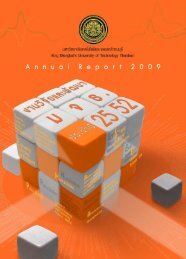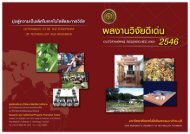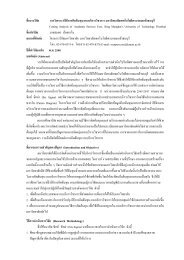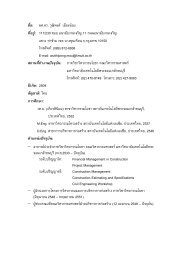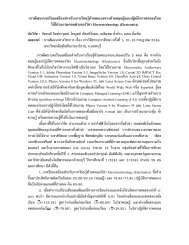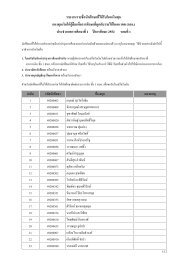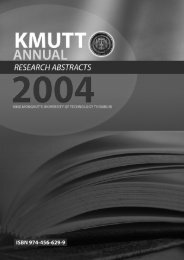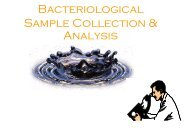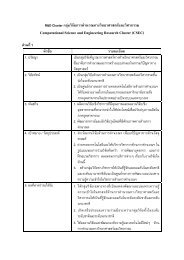You also want an ePaper? Increase the reach of your titles
YUMPU automatically turns print PDFs into web optimized ePapers that Google loves.
116<br />
for Hg 2+ with a mean residence time of 87 ps,<br />
whereas several water exchange processes were<br />
found between the second hydration shell and<br />
the bulk for all metal ions. For water exchange<br />
processes between the second hydration shell<br />
and the bulk, the mean residence time of 10 ps<br />
for Cd 2+ is nearly the same as that observed for<br />
Hg 2+ (13 ps), whereas the values of 22 ps and 55<br />
ps were evaluated for Cr 3+ and Co 3+ ,<br />
respectively.<br />
IC-117 DETERMINATION OF CHROMIUM,<br />
MANGANESE, CADMIUM AND LEAD IN<br />
SEAFOODS BY FLAME ATOMIC<br />
ABSORPTION SPECTROSCOPY<br />
Greeta Mathap, Burin Limchawfar,<br />
Surasak Sujaritvanichapong<br />
The 11 th Asian Chemical Congress (11th ACC),<br />
August 24-26, 2005, Korea University, Seoul,<br />
Korea<br />
This research undertook the quantitative<br />
study of chromium, manganese, cadmium and<br />
lead in seafoods e.g. cockle, sea mussel, sea<br />
crab and white bass from coastal areas<br />
in Bangkoontein, Bangkok, Pak Klong<br />
Mahachai, Samutsakorn and Bangprakong<br />
Rivers in Thailand by Flame Atomic Absorption<br />
Spectroscopy. It was found that chromium<br />
content in cockle, sea mussel, sea crab and white<br />
bass was 1.14 - 1.52 mg/kg, 1.16 - 1.23 mg/kg,<br />
0.69 - 1.14 mg/kg and 0.59 - 0.93 mg/kg,<br />
respectively. Manganese in cockle, sea mussel,<br />
sea crab and white bass was 9.83 - 11.29 mg/kg,<br />
12.81 - 15.27 mg/kg, 16.22 - 18.04 mg/kg and<br />
0.11 - 0.062 mg/kg, respectively. Cadmium in<br />
cockle, sea mussel, sea crab and white bass was<br />
1.46 - 2.04 mg/kg, 0.11 – 0.26 mg/kg, 0.15 -<br />
0.31 mg/kg and 0.06 - 0.15 mg/kg, respectively.<br />
Lead in cockle, sea mussel, sea crab and white<br />
bass was 0.34 - 1.56 mg/kg, 0.62 - 1.42 mg/kg,<br />
0.39 - 0.65 mg/kg and 0.34 - 0.70 mg/kg,<br />
respectively. The precision of the analysis was<br />
in the range of standard deviation form ± 0.003<br />
to ± 0.001, The relative standard deviation was<br />
in the range of ± 0.001 to ± 0.0100. The results<br />
show that the heavy metals in cockle, sea<br />
mussel, sea crab are more than those in white<br />
bass. Especially, cadmium in cockle is more<br />
than the Thai Ministry of Health standard limit<br />
(found 1.46 - 2.04 mg/kg, standard limit 1<br />
mg/kg).<br />
IC-118 REMOVAL OF ACRIDINE ORANGE<br />
KMUTT Annual Research Abstracts 2005<br />
DYE FROM AQUEOUS SOLUTIONS USING<br />
POLY(AMINOSTYRENE)<br />
Withawat Mingvanish, Benchang Sangchakr,<br />
Suwanna Faktim, Pannipa Kamsathon<br />
The 11 th Asian Chemical Congress (11th ACC),<br />
August 24-26, 2005, Korea University, Seoul,<br />
Korea, p. 294<br />
The use of poly(aminostyrene) as<br />
sorbent of Acridine Orange dye from aqueous<br />
solutions was studied. The effect of contact time,<br />
initial pH of the solution and dye concentration<br />
on the sorption were established. The<br />
concentration of dye solution remaining at<br />
equilibrium was measured by UV-Visible<br />
spectroscopy at the wavelength of 491 nm. The<br />
experimental data was described by Langmuir<br />
isotherm with a high correlation coefficient.<br />
IC-119 KINETICS OF COPPER(II) AND<br />
ZINC(II) ADSORPTION ON<br />
POLY(AMINOSTYRENE)<br />
Benchang Sangchakr,<br />
Kwan Thumrongwonggawin,<br />
Wirote Kaewkamphonkul, Withawat Mingvanish<br />
The 11 th Asian Chemical Congress (11th ACC),<br />
August 24-26, 2005, Korea University, Seoul,<br />
Korea, p. 346<br />
Kinetics and mechanism of adsorption<br />
of copper(II) and zinc(II) from aqueous<br />
solutions using poly(aminosytrene) were studied<br />
in the temperature range 303-348 K. Two<br />
simplified kinetic models, pseudo first- and<br />
second-order equations were tested. It was<br />
shown that the adsorption of both metal ions<br />
could be described by the pseudo second-order<br />
equation. Rate constants of the best-fit model<br />
were calculated and the related apparent<br />
activation energies were also evaluated and<br />
discussed.<br />
IC-120 PREPARATION OF MICROPOROUS<br />
NUCLEAR TRACK ETCHED MEMBRANE<br />
FROM THIN POLYCARBONATE FILM<br />
Apaporn Thongphud, Wichian Ratanatongchai,<br />
Benchang Sangchakr, Pinpan Visal-thaphand<br />
The 3 rd Regional Symposium on Membrane<br />
Science & Technology, April 26-27, 2005,<br />
Institut Teknologi Bandung, Indonesia<br />
Microporous nuclear track etched<br />
International Conference


